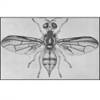Abstract
This fruit fly is one of the most important pests of citrus in Japan. There have been no interceptions of the Japanese orange fly in the United States, probably due in a large part to the protection provided by a U.S. embargo of long standing against citrus from the orient. There have been some efforts recently to affect the removal of this embargo in order that citrus from Japan might be exported to the U.S. If this were to be done, the danger of introducing the Japanese orange fly into the U.S. would be greatly increased. This revised 2-page fact sheet was written by H. V. Weems, Jr. and T. R. Fasulo, and published by the UF Department of Entomology and Nematology, March 2012.
References
Miyake T. 1919. Imperial Cent. Agricultural Experiment Station Bulletin (Tokyo) 2: 85-165, Illustrations in English. 1919. Review of Applied Entomology 7: 238-239.
Chen SH. 1940. Sinensia 11: 131-135; 1941. Review of Applied Entomology 29: 524.
Chen SH. 1940. Senensia 11: 577-587; 1942. Review of Applied Entomology 30: 71.
Sun CY, I-Lung D, Liao Y-M. 1958. Preliminary studies on the Chinese citrus fly, T. citri Chen. Acta Oecon, Ent. Sinica (Peking) 1: 175-187. In Chinese, English Summary.
Yasumatsu, K, Nagatomi A. 1959. Kyushu University Faculty of Agr. Sci. Bulletin 17: 129-146. In Japanese, English Summary.
USDA, Survey and Detection Operations, Plant Pest Control Division, Agricultural Research Service. Anonymous. 1961. Insects not known to occur in the United States. Cooperative Economic Insect Report 11-1-36. Japanese Orange Fly (Dacus tsuneonis Miyake): 29-31.
White IM, Elson-Harris MM. 1994. Fruit Flies of Economic Significance: Their Identification and Bionomics. CAB International. Oxon, UK. 601 pp.

